This event now concluded. Report available here.
- Lecturer: Komatsu Kazuhiko
(Director-General, International Research Center for Japanese Studies [Nichibunken]) - Date: Friday, September 19, 2014, 6:00-7:30 pm
- Venue: Lecture Hall, International House of Japan
- Language: Japanese (without English interpretation)
- Co-organized by: International Research Center for Japanese Studies (Nichibunken)
- Admission: Free
- Seating: 140 (Seats on a lottery basis. Registration up to 2 persons.)
- Registration Deadline: August 12, 2014
- (Applicants selected will be informed by the end of August.)
I-House is starting a series of forums in collaboration with Nichibunken to deepen the understanding of contemporary Japan from various perspectives. For the first forum, Professor Komatsu, a leading expert in yokai (monsters) research, will be the speaker.
Yokai has been widely received as a part of contemporary Japanese culture. The culture of yokai in Japan is a rich one and is a major current underlying the imagination and creativity of the Japanese people. Professor Komatsu will talk about how its unique characteristics and charm are used in contemporary creative activities in Japan.
Komatsu Kazuhiko
 Specializes in Cultural Anthropology and Folklore. Born in 1947 in Tokyo. He had been a professor at the International Research Center for Japanese Studies from 1997 and assumed his current position in 2012. Received the Medal with Purple Ribbon in 2013. His books include Yokai gaku shinkou (New Thoughts on Yokai), and “Densetsu” wa naze umaretaka (Why Were Legends Made?) (Kadokawa Gakugei).
Specializes in Cultural Anthropology and Folklore. Born in 1947 in Tokyo. He had been a professor at the International Research Center for Japanese Studies from 1997 and assumed his current position in 2012. Received the Medal with Purple Ribbon in 2013. His books include Yokai gaku shinkou (New Thoughts on Yokai), and “Densetsu” wa naze umaretaka (Why Were Legends Made?) (Kadokawa Gakugei).
Report
From antiquity, the Japanese have personified supernatural phenomena, giving them physical shape and form, and portraying them in pictures and in tales, beginning as early as the Kojiki and the Nihon shoki, the historical chronicles of the Nara period (710–94), and the illustrated narrative scrolls, or emaki, of the Heian period (794–1185). A variety of types and forms of yokai also appear in popular legend—kappa (water sprites), tengu (long-nosed goblins), zashiki warashi (household spirits), and others. Over time yokai became divided into three major categories: (1) yokai such as orochi (giant serpents) and kitsune (fox spirits) deriving from the natural world; (2) yokai such as tsukumogami that were supernatural transformations of everyday tools; and (3) transformations of human beings into yokai (ghosts, etc.).

What is common to all varieties of yokai, in Komatsu’s analysis, is the animism at the root of traditional Japanese religious beliefs. Spirits inhabit all things, and can transform for good or ill within the context of their relationship with human beings. Yokai are a concrete manifestation of the harmful capacity of spirits, and as residents of the “dark side” of the history of Japanese religion and folk belief, are a deeply interesting subject for research.
Such monsters appear frequently in the folklore of all areas of Japan subject to natural disasters such as landslides, floods, tsunami, and typhoons. Komatsu stressed that legends and folktales have importance as a means of transmitting memory and wisdom concerning natural disasters, which should be studied, not just from the standpoint of the natural sciences, but also from the perspective of folklore and yokai studies. A valuable first step, Komatsu suggested, would be incorporating information on folklore, rituals, and other commemorative devices (shrines, stelae, etc.) into a hazard map database.
I-House is starting a series of forums in collaboration with Nichibunken to deepen the understanding of contemporary Japan from various perspectives.